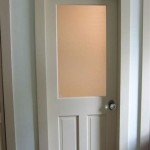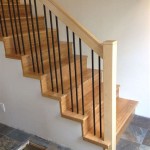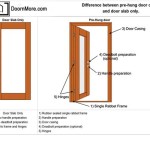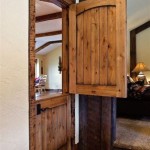What Does A Prehung Interior Door Mean?
When embarking on a home renovation project, particularly one involving door replacements, you might encounter the term "prehung door." This seemingly simple phrase holds significant implications for the installation process and ultimately, the final look and functionality of your interior doors. A prehung door is not just a door slab; it's a complete unit that includes the door itself, the jamb (the frame surrounding the door), and sometimes the casing (the trim that surrounds the jamb). Understanding the benefits and components of a prehung door can help you make informed decisions for your home improvement endeavors.
Benefits of Prehung Doors
Choosing prehung doors over traditional, separately purchased door slabs and jambs offers various advantages. These benefits contribute to a smoother installation process, a more professional finish, and improved longevity of your doors:
1. Simplified Installation
Prehung doors are preassembled, meaning that the door, jamb, and sometimes even the casing are already attached at the factory. This pre-built system eliminates the need for time-consuming and potentially error-prone on-site assembly. The entire unit is ready to be hung in the rough opening, reducing the complexity of the installation process and minimizing the potential for misalignment issues.
2. Improved Accuracy and Fit
Factory-built prehung doors are manufactured with precision, ensuring that the door, jamb, and casing components fit perfectly together. This precise construction minimizes gaps and misalignments, resulting in a professional-looking and tightly sealed door that contributes to soundproofing and energy efficiency. The pre-installed components also eliminate the risk of mismatched hardware or inconsistent styling, offering a uniform and consistent finish throughout your home.
3. Reduced Risk of Damage
The pre-assembled nature of prehung doors significantly reduces the potential for damage during transportation and installation. The door slab is protected within the frame, minimizing the risk of scratches, dents, or other blemishes that can occur when handling separate components. This protection ensures that your new doors arrive at your home in pristine condition, ready for installation.
Components of a Prehung Door
Prehung doors come in various configurations, but the basic components are consistent. Understanding these components helps you select the right door for your needs and ensure a smooth installation process:
1. Door Slab
The door slab is the visible portion of the door, the part that you interact with directly. It can be made from various materials, including solid wood, engineered wood, fiberglass, or composite materials. The door slab's style, design, and finish are crucial factors in creating the desired look and feel for your interior spaces.
2. Jamb
The jamb is the frame that surrounds the door slab. It provides structural support and guides the door's movement. Jambs are typically made of wood or composite materials and can be finished to match your desired aesthetic. There are different types of jambs available, including traditional, colonial, and craftsman styles, allowing you to choose a design that complements your home's existing architectural style.
3. Casing (Optional)
The casing is the trim that surrounds the jamb. It acts as a decorative element, providing a finished look around the door opening and concealing any imperfections in the wall surface. Casing can be made of wood, composite materials, or even MDF and is available in a variety of profiles to suit different design preferences. Not all prehung doors come with casing, so it's essential to check the specifications before purchasing.
4. Hardware
Prehung doors typically don't come with hardware. The hardware, including hinges, door knob, and strike plate, need to be purchased separately. Your choice of hardware will determine the door's functionality and style. You can choose between traditional, modern, or contemporary designs to enhance the overall aesthetics of your interior doors.
Choosing the Right Prehung Door
Selecting the right prehung door involves considering several factors that impact both the installation process and the final outcome. These factors include:
1. Door Size:
The size of the prehung door should match the rough opening in your wall. Measure the rough opening carefully to ensure a snug fit. It's important to consider the thickness of the wall as well as the door's dimensions.
2. Door Style:
There are various door styles available, from traditional to contemporary. Consider your home's architectural style and your personal preferences when selecting a prehung door style.
3. Door Material:
The material of the door slab will affect its durability, cost, and aesthetic appeal. Choose a material that meets your needs and budget while complementing your overall design scheme.
4. Jamb Style:
The jamb style determines the appearance and functionality of the door frame. Choose a style that complements your door slab and enhances your interior design.
5. Casing:
If you require casing, ensure that the prehung door option includes it, or purchase it separately. Consider the casing style, profile, and material to achieve a cohesive look.
Installation Considerations
While providing numerous advantages, prehung doors still require proper installation to ensure a seamless fit and optimal performance. Here are some installation considerations:
1. Professional Installation:
While prehung doors simplify the process, professional installation is recommended to ensure a precise and secure installation. Experienced installers have the expertise to handle any potential challenges and guarantee a professional finish.
2. Rough Opening Preparation:
The rough opening needs to be prepared accurately to accommodate the prehung door. This involves ensuring that the opening is square, plumb, and the correct size. Proper preparation eliminates potential issues during the installation.
3. Framing and Shimming:
The jamb may require shimming to ensure a perfectly level and plumb installation. This process involves placing thin strips of wood between the jamb and the wall framing to adjust and secure the door frame.
4. Hardware Installation:
Install the hardware according to the manufacturer's instructions. Ensure that the hinges are properly aligned and the door knob is correctly installed to ensure smooth operation and longevity.
In conclusion, prehung interior doors offer significant advantages in terms of installation simplicity, accuracy, and protection. Understanding the benefits and components of prehung doors empowers you to make informed decisions for your renovation projects, ensuring a seamless and professional outcome for your interior door replacements.

Prehung Door Vs Slab Doors Help

Difference Between Pre Hung Vs Slab Door Riverside Millwork Group

Prehung Doors Important Tips More Blog

Prehung Vs Slab Doors What To Know Before Sans Soucie

Prehung Doors Important Tips More Blog

Everything You Need To Know About Parts Of A Door Sans Soucie

Pre Hanging Information

Pre Hung Doors Vs Slab Which One Should You Choose Cosmaroma

Slab And Prehung Doors What S The Difference You Re Getting Sans Soucie Art Glass

How To Install A Door For Wood Doors And Assembled Pre Hung Homestead Interior
Related Posts








